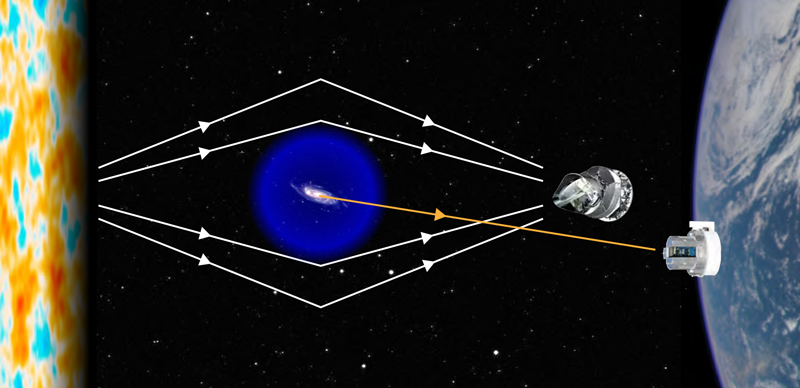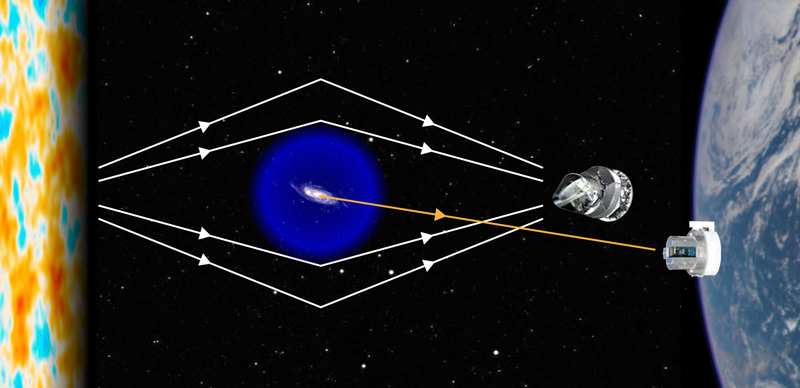Dark Matter Mapped Around Distant Galaxies
Investigating the properties of galaxies is fundamental to uncovering the still-unknown nature of the dominant forms of mass and energy in the Universe: dark matter and dark energy. Dark matter resides in “halos” surrounding galaxies, and information on the evolution of this invisible substance can be obtained by examining galaxies over a wide range of cosmic time. But observing distant galaxies—those at high redshifts—poses a challenge for astronomers because these objects look very dim. Fortunately, there is another way to probe the dark matter around such galaxies: via the imprint it leaves on the pattern of cosmic microwave background (CMB) temperature fluctuations through gravitational lensing (Fig. 1). Hironao Miyatake at Nagoya University, Japan, and his colleagues have now used measurements of such lensing, combined with information on the distribution of galaxies throughout space, to map the dark matter around distant galaxies at a redshift of about 4 [1]. They report the first cosmological analysis using galaxies at such a high redshift.
The study of the CMB fluctuations, as observed by the Planck satellite, has enabled the properties of the Universe to be constrained with remarkable precision [2]. Since the CMB photons started to propagate, about 13.5 billion years ago, the Universe has expanded while galaxies have formed and assembled into larger and larger structures. Over the past few billion years, dark energy has caused the expansion to accelerate. The cosmological models that describe the physics of the early Universe, taking into account the constraints set by the CMB measurements, predict how matter evolves over time. Therefore, astronomers can observe the late-time large-scale structure of the Universe and see how well the data support the models. This large-scale structure is commonly studied by measuring the gravitational-lensing effect on background galaxies by foreground galaxies or by considering the galaxy-galaxy clustering—a measure of the excess probability of finding a pair of galaxies at a given separation in the sky relative to a random distribution.
Astronomers have found something very interesting when using these observations to constrain cosmology: results based on large-scale-structure data suggest that matter has not clumped together as much as CMB data from the Planck satellite indicate [3–5]. The degree of clumping is quantified by the parameter 𝜎8, which is roughly the amplitude of density fluctuations. It is unclear whether the different values of 𝜎8 derived from the two types of data reflect unknown systematic effects or physical mechanisms. But determining the matter distribution in different epochs of cosmic history might provide a clue. Moreover, combining different observables has been shown to be highly effective at probing the growth of cosmic structures [3, 6, 7]. In particular, the signal from the gravitational lensing of CMB light is especially suitable for studying the large-scale structure of the Universe at redshifts higher than 1, where this lensing effect is strongest and where background galaxies are difficult to find.
Using Planck data, Miyatake and colleagues investigated the imprints left by high-redshift galaxies on the CMB lensing map. The team found a clear lensing signal produced by about 1.5 million high-redshift galaxies known as Lyman-break galaxies (LBGs) that were identified in the Hyper Suprime-Cam Subaru Strategic Program survey. The researchers compared this lensing signal with a model of the dark-matter distribution around the galaxies that depends on parameters such as the average mass of a dark-matter halo. By doing so, they set a constraint on the average halo mass that is consistent with the typical abundance of dark matter around these LBGs.
Miyatake and colleagues also combined the cross-correlated signal of the CMB lensing and of the LBGs’ positions with the galaxy-galaxy clustering of these objects. That combination constrains the extent to which matter has spread and clumped together in the Universe through the 𝜎8 parameter. The team obtained a value for 𝜎8 that is slighter lower than that indicated by the Planck data alone, representing the first constraint on this parameter using LBGs at a redshift of about 4. Furthermore, the researchers demonstrated the feasibility of using this analysis to test different dark-energy models and to determine the contributions of luminous and dark matter to the total mass of these LBGs.
Several important sources of systematic error could bias these estimates. Such sources include uncertainties in the estimated LBG redshifts and contamination of the CMB lensing signal from background galaxies and from the cosmic infrared background—infrared radiation emitted by dusty star-forming galaxies. The team carried out several tests to estimate the impact of these errors, finding no evidence of induced bias.
Miyatake and colleagues’ work delivers a very relevant message: it is possible to probe the growth of cosmic structures when the Universe was only a billion years old—or younger. This message is timely because astronomers are transitioning to the next generation of CMB and of large-scale-structure surveys. High-resolution CMB experiments, including those of the Simons Observatory in Chile and of CMB-S4 in Chile and at the South Pole will soon carry out multifrequency observations, allowing the CMB lensing map to be reconstructed with unprecedented precision. Meanwhile, galaxy surveys by the Vera C. Rubin Observatory, also in Chile, and the Nancy Grace Roman Space Telescope will provide outstanding LBG measurements. Analysis in the same direction as Miyatake and colleagues’ study will allow astronomers to explore cosmic growth in a still-obscure epoch of the Universe. It will potentially place strong constraints on the mysterious dark sector of the Universe and help to decipher the source of the 𝜎8 tension.
References
- H. Miyatake et al., “First identification of a CMB lensing signal produced by 1.5 million galaxies at z∼4 : Constraints on matter density fluctuations at high redshift,” Phys. Rev. Lett. 129, 061301 (2022).
- N. Aghanim et al., “Planck 2018 results—I. Overview and the cosmological legacy of Planck,” Astron. Astrophys. 641, A1 (2020).
- C. Heymans et al., “KiDS-1000 Cosmology: Multi-probe weak gravitational lensing and spectroscopic galaxy clustering constraints,” Astron. Astrophys. 646, A140 (2021).
- T. Tröster et al., “Cosmology from large-scale structure—Constraining ΛCDM with BOSS,” Astron. Astrophys. 633, L10 (2020).
- T. M. C. Abbott et al., “Dark Energy Survey Year 3 results: Cosmological constraints from galaxy clustering and weak lensing,” Phys. Rev. D 105, 023520 (2022).
- T. Giannantonio et al., “CMB lensing tomography with the DES Science Verification galaxies,” Mon. Not. R. Astron. Soc. 456, 3213 (2016).
- C. García-García et al., “The growth of density perturbations in the last ∼ 10 billion years from tomographic large-scale structure data,” J. Cosmol. Astropart. Phys. 10, 030 (2021).





